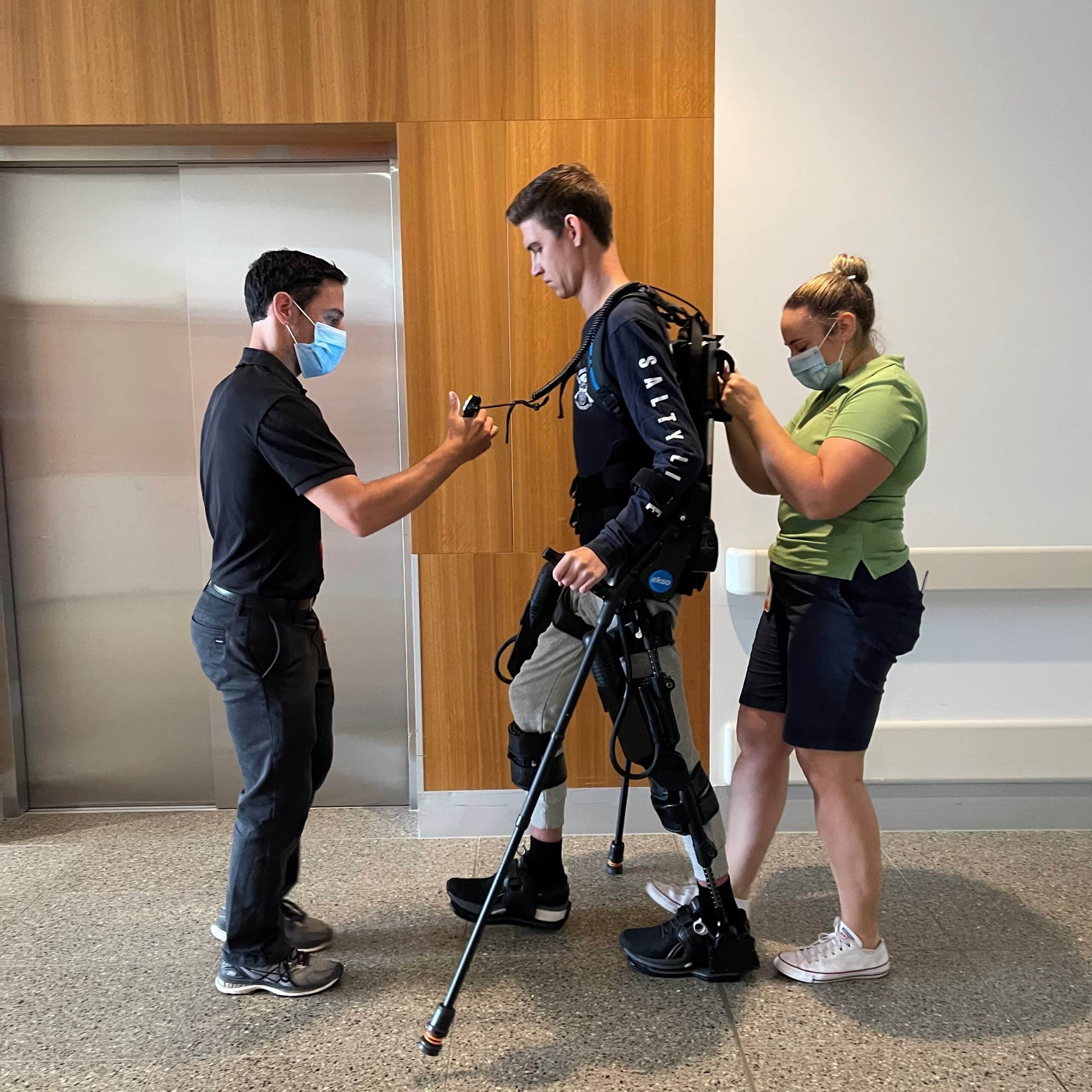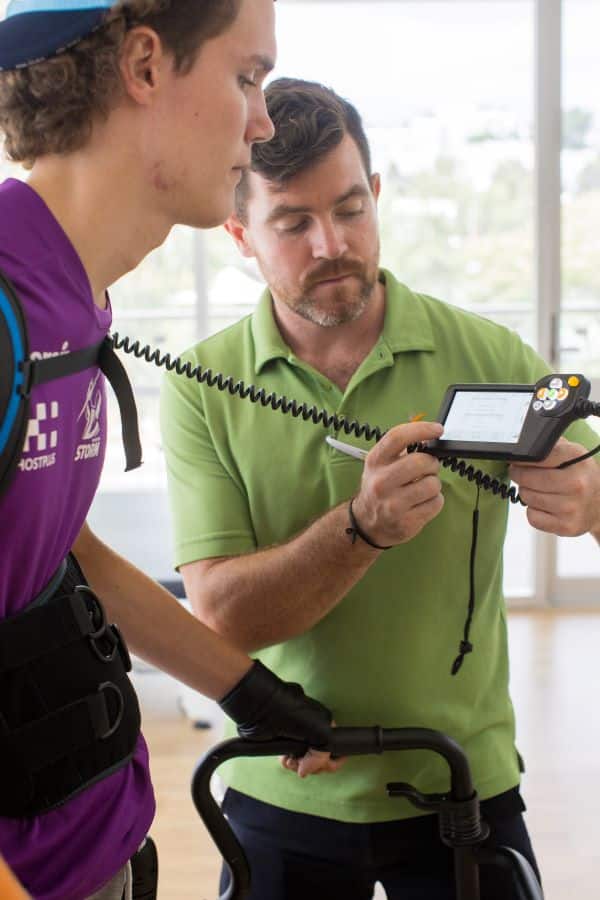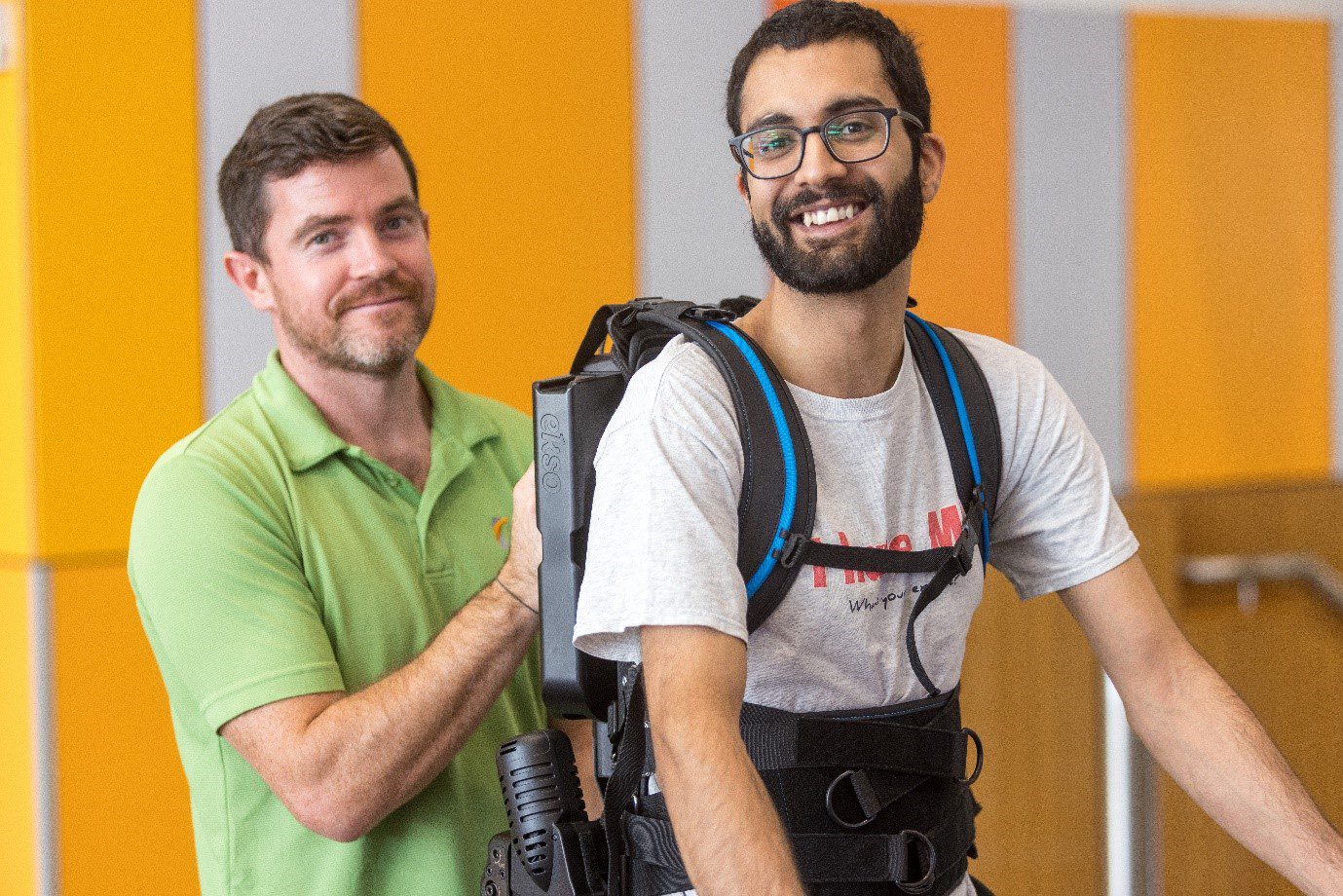Technology has done much to improve human lifestyle, helping us progress in so many ways. Possibly the most important way is the advancement of therapies and assistive tools available to people with disabilities. Last year, leading not-for-profit rehabilitation and disability support provider Royal Rehab added EksoNR advanced robotic exoskeleton to its offering. An exciting development, and the first of its kind in Australia.
EksoNR is a type of exoskeleton that uses the wearer’s own weight-bearing capacity to rebuild muscle capacity. It’s being used to help people with limited mobility gain the ability to stand, walk better and transfer. We spoke to Jason Redhead, Assistive Technology Lead and Senior Physiotherapist at Royal Rehab, to find out more.
Royal Rehab has a holistic approach to therapy
Royal Rehab is the first organisation in the world to complete EksoNR accreditation virtually, due to the pandemic. Subsequently, EksoNR therapy was introduced into a wider range of physiotherapy at Royal Rehab in November 2020.
The nationally renowned service provider now has 10 fully accredited clinicians and doesn’t plan to stop there. Royal Rehab also has a train-the-trainer program and is able to train inhouse its new staff to safely and effectively using EksoNR.
As Jason explains during an interview with Blue Badge Insurance, the EksoNR robotic exoskeleton is just one of several aspects of rehabilitation. It’s generally used in conjunction with several other therapies to meet a client’s goals. Royal Rehab values highly this holistic approach in pursuit of the best results for clients.
For 71-year-old Ken, the EksoNR has had a positive impact on improving his ability to walk. Watch the below video to see Ken’s journey:
Who can benefit from EksoNR therapy?
People with lower limb muscle weakness or paralysis may benefit from EksoNR therapy. Royal Rehab uses EksoNR in personal therapy programs to assist with the following conditions:
- Spinal cord injury
- Multiple Sclerosis
- Parkinson’s disease
- Acquired brain injury
- Stroke
- Guillain-Barré syndrome
Read our article on Brain Awareness Week to see how Multiple Sclerosis and Parkinson’s can affect mobility.
Medical assessment for EksoNR rehabilitation
Prior to using the robotic EksoNR, Royal Rehab completes a physical assessment to see if EksoNR is appropriate for the client. There are several clinical criteria, such as height range, weight limit, joint range and spasticity, which need to be met for EksoNR to be suitable.
There are also a number of health requirements that must be met. The client also needs to be able to communicate to the degree required to manage the active engagement required.
Lastly, a doctor or neurologist must be onboard to give medical clearance. This is to indicate it’s medically safe for the client to use EksoNR in a weight-bearing program. It also shows it’s physically safe for them to stand (with the guidance and support of the device and physiotherapists).

Learning to use the robotic EksoNR suit
Once a client has the all-clear, they can try EksoNR on. In this first session, clinicians spend a lot of time calibrating the suit to perfectly match the user’s body. These settings are recorded so they can be reset for each subsequent session when the process becomes much quicker. During this session the clinician will educate the client on what to expect to prepare them for the new sensation of the technology.
At first, the client must relinquish a lot of control, as they learn how the EksoNR operates. The clinician will initially trigger the first step while the client gets used to it. The program shifts from passive to active therapy as the client learns to trigger each step using their weight-bearing capacity and muscle activity.
EksoNR is an exciting technology for clients and clinicians alike because it’s interesting and engaging. The progressive technology allows clinicians to really challenge clients, possibly beyond the safety or capabilities they may have been able to achieve without EksoNR
– Jason Redhead
Assistive Technology Lead and Senior Physiotherapist at Royal Rehab
As Jason explains, robotic EksoNR rehab challenges the user to think about each step through active participation. As they work on posture, strength and joint range, the EksoNR sends auditory and visual signals to a palm pad sharing real-time data. This data helps the user understand what adjustments to make to step length, gait training and other aspects of mobility. Aspects the brain is not used to having to consciously focus on.
Throughout the process, clinicians review aspects of step trajectory and gait training and make changes to the program to allow for success. In this way, the rehabilitation adapts as the client progresses and is constantly tailored to help them further develop their skills.
Royal Rehab shares the EksoNR message
Ekso Bionics has a slogan – “feel it, learn it, lead it” – and as Jason says, this is so true. As the wearer gets used to the experience of feeling and being guided by the device, they begin to learn it and become active in the process. Once this progresses, they need to lead it.
The forerunner to the EksoNR was the EksoGT, launched by Ekso Bionics in 2005. Since then, Ekso Bionics has made major technological advances to the suit’s safety features and real time data feedback mode, creating the new generation EksoNR.
Some of the new features include:
- Advanced FreeGait mode. Allows you to focus on correcting gait symmetry, strength and speed for improved community ambulation.
- Dynamic step movement. The suit supports walking forwards, backwards and side-stepping
- EksoPulse portal. This digital portal stores your data so you can analyse and track your progress and focus on areas of activity that require specific work.
- Adjustable. The suit is able to adjust using software while the patient is walking.
- Metric progress tracking. Real-time feedback from the technology gives the wearer detailed analysis and graphs that are enormously motivating and user-friendly.
Having your own data guide you on shortcomings also alleviates the sense of having to overcome enormous challenges those around you may not have experienced. Essentially the clinicians support you and guide you, but EksoNR allows you to be far more active – and requires you to be – in your own success.

EksoNR now available in Australia at Royal Rehab
The EksoNR advanced robotic exoskeleton being available in Australia at Royal Rehab means better outcomes are delivered to a number of people living with neurological conditions and injury such as stroke, spinal cord injuries, multiple sclerosis, acquired brain injury and more.
You can access the EksoNR through Royal Rehab’s inpatient and day rehab programs, as well as through your relevant funding body such as NDIS, iCare or by self-funding. For more information on the EksoNR, visit www.royalrehab.com.au/eksoNR.
More benefits for people living with disability
The EksoNR suit is reshaping the face of physiotherapy and we look forward to hearing about ongoing technological advances.
Unfortunately, the lack of accessible parking spaces isn’t likely to change anywhere near as fast. Happily, if you have a disability parking permit, one silver lining is up to 25% discount on disability car insurance.
As Australia’s first independence and mobility insurance specialist, we offer fair, easy to understand and easy to use insurance. Get a quote now.








